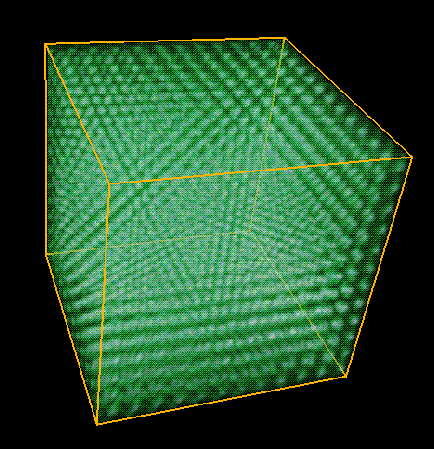Elastic Solids

U. S. Air Force 3-D elastic solid simulation developed on CAM-8.
The simulation space is 1/8 billion lattice sites.

Early experience with our CAM-8 hardware by U. S. Air Force researchers stimulated the Air Force to launch a new initiative from Phillips Labs, which started last year. Working closely with us, this initiative is studying the use of lattice-gas and related simulation methods for geophysical modeling. They have already made significant breakthroughs, discovering new methods of simulating crystal growth in complex flowing fluids -- methods that are only practical on machines optimized for spatially organized, lattice-gas kinds of models.
CAM-8 is such a machine. Developed with ARPA HPCC funding, its specialized architecture gains orders of magnitude in cost/performance by taking advantage of uniformity and spatial locality.
The lattice-gas crystalization models developed by the Air Force differ from conventional molecular dynamics simulations in that they are much simpler, involve no arithmetic calculations, and they take into account full n-body correlations. They have the potential to revolutionize several areas of materials modeling, including the study of binary alloys.
Updated 2/12/95 by Norman Margolus (nhm@mit.edu)For over a decade, the Information Mechanics Group here at the MIT Lab for Computer Science has pioneered the use of Cellular Automata (CA) for modeling physical systems. This research is part of a long term effort to better match computations to the constraints of physics, with the ultimate aim of effectively harnessing the truly astronomical fine-grained spatially-organized parallelism of microscopic physics. Promoting this modeling approach has involved us not only in new areas of algorithm development, but also in the design and construction of hardware that can take advantage of the uniformity, simplicity, and spatial locality of CA computations. Even our early, "toy" CA machines had an important effect on the research community: the entire field of lattice-gas hydrodynamics grew directly out of our early CA-machine and modeling work.
Our recent CAM-8 machine is designed to be a serious scientific CA computer: it constitutes a major breakthrough in our understanding of how to efficiently and flexibly model and analyze large-scale CA systems. This machine -- which has been running in prototype form for about two years -- is an indefinitely-scalable, mesh-architecture virtual-processor emulator for large cellular-logic arrays. Taking advantage of the uniformity and predictability of CA computations, all memory accesses and communication events are optimally ordered, pipelined and synchronized between processors: the machine makes optimal use of the full sequential-burst-access memory bandwidth of conventional DRAMs. Modern high-bandwidth DRAMs provide a natural upgrade path for this kind of architecture. This hardware demonstrates that, for large-scale lattice-gas and CA kinds of computations, purely architectural innovations can lead to about a three order of magnitude cost/performance improvement over commercial architectures.
Our current efforts are aimed mainly at developing CA algorithms on CAM-8, along with the attendant development of the languages, utilities, and programming environments necessary for a serious research instrument and modeling platform. We have placed a strong emphasis on collaborative research, working with experts spanning a wide range of disciplines in order to identify and develop ``breakthrough'' applications that convincingly demonstrate the power of spatially organized computation.
More information is available on the CAM-8 architecture (see the paper, CAM-8: a computer architecture based on cellular automata), and on the current status of the CAM-8 project (including images from some sample applications. Information is also available on Information Mechanics Group members. A brief description of current and planned CAM-8 collaborations is also available. Finally, we also provide a brief summary of our near-term software plans.